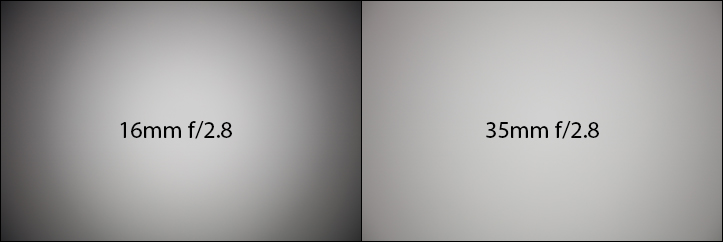|
Canon EF 16-35mm f/2.8 USM L III - Review / Test - Analysis |
|
Lens Reviews -
Canon EOS (Full Format)
|
|
Page 2 of 3

Distortion
The distortion characteristic of the Canon EF 16-35mm f/2.8 USM L III is typical for a lens in this class. At 16mm you have to live with a rather strong barrel distortion (3.6%). This eases at 20mm (1.5%) and images are essentially free of distortions at 24mm. At 35mm there's a medium degree of pincushion distortion (1.7%).
Vignetting
A major weakness is the high amount of light falloff in the image corners at 16mm @ f/2.8. A vignetting of 4.6 EV (f-stops) is WAY beyond our usual scale for full format lenses. Unless you have to go for f/2.8 or simply like the effect, you should stop down to at least f/5.6 in order to reduce the light falloff to an moderate degree. The situation has eased a bit at 20mm but there's no glory here either at full open aperture. At 24mm there's still quite a bit of vignetting at f/2.8 but it's reasonably well controlled from f/4. At 35mm the vignetting is moderate also thanks to a very gradual light falloff towards the corners.

Below as sample image taken at the extreme ends of the zoom range at fully open aperture.

MTF (resolution) @ 50 megapixels
The resolution is pretty impressive on a high resolution camera. The center quality is outstanding across the board at least till diffraction kicks in at f/11. The near-center quality is very good to excellent at 16mm. The borders are also sharp whereas the corners are somewhat soft at f/2.8 here. The sweet spot is reached at f/5.6 where the corners are lifted to good to very good levels. The same characteristic applies to the 20mm setting. The corner softness at f/2.8 is gone at 24mm and the quality is very homogeneous across the mainstream aperture settings. The resolution of the outer images region decreases again at 35mm. The borders are just fair here and the corners are also quite soft. Stopping down to f/5.6 results improves the quality substantially again.
The centering quality of the tested sample was good.
Please note that the MTF results are not directly comparable across the different systems!
Below is a simplified summary of the formal findings. The chart shows line widths per picture height (LW/PH) which can be taken as a measure for sharpness.
If you want to know more about the MTF50 figures you may check out the corresponding Imatest Explanations
MTF (resolution) at 21 megapixels
Why are the MTFs sometimes "better" on 21 megapixels compared to 50 megapixels ? There are two reasons for this. Lateral CAs are lower in terms of pixel widths at 21mp simply because the pixel density is also lower. Extreme CAs that may exist at 50mp are therefore less affecting the measurements at 21mp. Generally we are also using a certain degree of sharpening during the image conversion (just like in real life images) and because the 21mp results are "sharper" on pixel level they are relatively more receptive to (mild base-) sharpening.
The majority of users are still using cameras with a more moderate pixel count so let's have a look how the lens performs with the eased requirements at 21 megapixels - also in order to be able to compare the results to older review. The center quality remains, of course, extremely high but the borders/corners are "boosted" (relatively speaking). The borders are extremely sharp at 16mm and the corners make it to good to very good levels even at f/2.8. Same goes for the 20mm setting. The homogeneous image characteristic remains at 24mm and the lens can almost exploit the sensor potential to the max here. The somewhat lower quality at 35mm is also apparent on 21 megapixels thus it remains advisable to stop down to at least f/4, better f/5.6 for optimum results.
Please note that the MTF results are not directly comparable across the different systems!
Below is a simplified summary of the formal findings. The chart shows line widths per picture height (LW/PH) which can be taken as a measure for sharpness.
If you want to know more about the MTF50 figures you may check out the corresponding Imatest Explanations
Chromatic Aberrations (CAs)
Lateral chromatic aberrations (color shadows at harsh contrast transitions) are extremely well controlled between 16mm and 24mm. The CAs are somewhat higher at 35mm but they remain unobtrusive with an average pixel width of around 1.3px at the image borders.
Note: These are the results at 50 megapixels.

Flare
Ultra-wide lenses cover an immense field of view thus you may run into scenes where a strong light source such as the sun is either part of the composition or it affects the image via parasitary light from just outside of the image frame. Glare and ghostings are frequent issues in such cases. As mentioned during the introduction Canon has applied ASC and SWC (coating) to the lens elements to reduce the problem. Did they succeed ? Well, mostly. Below is a rather extreme test scene (note: it's not meant to be a nice image) with the sun positioned in one corner. As you may see the image contrast remain unaffected - which is great. However, a few ghostings remain - more so at f/8 than at f/2.8. Please also note that the sun shows a distinctive "star" effect at f/8 whereas it's a blurry sharp at fully open aperture. Generally we would rate the flare behaviour as well above average (no lens is perfect here).
As a side note - the image was taken at 16mm thus you can also observe the extreme vignetting at f/2.8 in the image to the left.

|